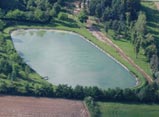Wastewater treatment: one plant, two setups
Animation illustrating the wastewater routing with the two setups
Clic on each setup to follow the water’s progression, from the particular individual to the stream
Winter setup
In the winter, the wastewater passes successively through both filtering stages (primary and secondary filters). This approach insures compliance with the required outlet quality with entrance loads up to 4000 PE (and probably more, as suggested by the outlet quality observed in 2009 and 2010 with loads around 3000 PE). The ponds are not included in the winter setup because their treatment efficiency is low at few sunshine hours and low temperatures. Nevertheless they receive the raw wastewater of Nègrepelisse in case of accidental plant dysfunction (power breakdown for example) and insure a minimum treatment before re-establishment of the CW plant.
Summer setup
In the summer, i.e. from March or April to October or November, the wastewater flows through the ponds between the two filtering stages in order to reduce the phosphorus and especially the nitrogen contents in a period of minimum flow and maximum sensitivity of the creeks. This is achieved with a small energy consumption because waters are pumped as they arrive, in small flow thus with small pumps.
The lowering of the phosphorus and nitrogen contents throughout the ponds is an innovation, practiced since 2007 on the Saint-Etienne-de-Tulmont wastewater plant, another CCTVA project. The experimental research on both plants is handled by SATESE 82.

Two treatment ponds (summer regime)
The primary ponds are integrated into the Nègrepelisse wastewater plant’s treatment steps.
Read the article